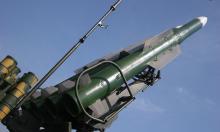Step Into Russia’s Past and Experience Its Grandeur - 21 October, 2002 - News
Tsar’s arsenal exhibition, filled with fantastic examples of craftsmanship
What happens when you put a military veteran and avid hunter in a room filled with priceless weapons? First of all, he better have an escort so nothing suddenly disappears. Second, give him a rag to wipe the drool from his mouth and most importantly don’t be surprised if while looking at a display he suddenly appears to be in a coma. It’s ok; he’s just fantasizing about hunting with Peter the Great or Alexander III.
The current Kremlin exhibition of the Tsar’s arsenal gave me a once in a lifetime chance to view some of the most exquisite examples of firearms, armor and blade work I have ever seen. The exhibition, sponsored by Rosbank and presented by the State Museums of the Moscow Kremlin, showcases not only weapons, but symbols of Tsarist power as well.
With the help of Zelfira Tregulova, Deputy Director of the Museum’s International Department and Vera Sarkisova, the department’s Chief Expert, I was given a first hand look into Russia’s past and the sheer beauty of objects crafted some three and four hundred years ago for use by various Tsars and Tsarinas for battle as well as pleasure.
The exhibition covers the period from the 17th to the early 19th century and contains the best examples of arms belonging to Russian Tsars and empresses of the 2nd Dynasty, which first came to power in the early 17th century. The exhibition represents objects connected with 10 Tsars of the Romanov Dynasty. One such object is a helmet that was originally made for Michael Romanov, the first Tsar of the Dynasty. It is part of the “grand attire of Russian Tsars” and grand it is, adorned with gold and jewels it definitely projects regal power. Other items connected with the grand attire are a gold and jewel inlaid bow case and quiver, which contain the coat of arms of St. George and the two-headed eagle. The original cost of these two items was 2,200 Rubles, this at a time when the best paid Kremlin craftsman earned just 250 Rubles a year.
I was awestruck by the workmanship that went into creating these items. It is simply amazing how well the weapons and armor was made, considering the crude tools the craftsmen of the time were using. The workshops of the Kremlin used a combination of the best Russian craftsmen as well as those invited from other countries. The Eastern influence is obvious in several of the items, including the axes carried by the Tsar’s personal guards. They too are covered with gold and the crescent shaped blades are engraved with the symbols of the House of Romanov.
There were fine examples of chain mail armor, used both in battle and as parade wear. This was the traditional armor of the Russian soldier for centuries. Russian chain mail was highly prized throughout Europe and was often bought by Western European kings and noblemen. A typical set of armor weighed about 10kg and until the introduction of firearms in the 15th century could stop arrows and spears from penetrating. Not until the middle of the 17th century did Russian troops begin to wear full metal armor. Several so-called New Regiments were formed using warriors who were invited to Russia from foreign countries. They brought with them the new type of armor and used it exclusively.
Imagine what it must have been like to be a soldier during that time. All combat was fought hand to hand with some very nasty weapons, no shooting at each other from 300 yards in those days. Killing was an up front and personal, “in your face” affair. We have all seen the movies about medieval knights in their shining armor fighting for the fair maiden. It is often portrayed as a very clean and orderly process, when in reality, it was quite brutal and bloody. I have read accounts of ancient battles that stated, “the blood was knee deep” and “the rotting corpses were piled eight feet high.” Exaggerations, possibly, but I would bet not by much. I have personally witnessed (more times than I cared to) decomposing bodies; victims of shootings, stabbings, bombings, mutilations, fires, traffic accidents and suicides, just to name a few and I can tell you it’s not a pretty sight.
So try to put yourself in that soldier’s place, think about what must have been going through his mind when he saw hundreds, if not thousands, of the enemy marching toward him. All the while knowing he would have to charge into the opposing mass slashing and cutting his way through. Blood and body parts everywhere,the screams of the wounded crashing in on him like waves on a stormy sea, the stench of blood and sweat filling his nostrils. His chances for survival were slim to none and he knew it. He was probably no more than 16 or 17 and from a poor family, not the regal knights we’re used to.
It is ironic that through the centuries weapons advancement was made possible through military technology, yet the military rarely was able to use the advanced weapons they were responsible for creating. During the famous Battle of the Little Bighorn, U.S. Calvary troops led by Gen Custer were outnumbered 10 to 1 by several tribes of Indians. The soldiers were slaughtered, in part because they were forced to use inferior firearms while the Indians were equipped with the latest repeating rifles. It was even documented that much of the Army’s ammunition would not fit into the soldier’s rifles.
I have been to thisbattlefield in southeastern Montana and have seen the graves of the fallen soldiers (they were originally buried on the spot where they died) and I have heard the details of the battle. Different time, different place, but the soldier’s description remains the same. The young man fighting and dying on the plains of the West was young, usually poor, and had to fight not only his enemy but also the weather, his inferior equipment and at times, even his own superiors. The Indians are charging toward you on horses at full gallop, screaming their war cries as they descend upon the Calvary soldier. He is on foot, having to shoot his own horse to use as cover from the savage’s bullets and arrows. He is forced to use an outdated single shot rifle against the enemy’s repeaters. As he tries to reload in the face of impending death, the cartridge jams in his rifle’s barrel, rendering it useless. The last thing he sees is the bloody tomahawk crashing into his skull. The Russian military has not been immune to such things either, no military has.
On display at the exhibition were examples of some of the most advanced firearms in the world, for their day, and they were all developed here in Russia. Weapons with rifled barrels were used by the Tsars for hunting as early as the 17th century. However, it would be nearly 200 years before this same technology would be used by a very small number of British troops during the Napoleonic Wars. In that time, the best soldier could fire three shots per minute accurately. The small British unit called Sharpe’s Rifles could fire five shots in the same amount of time. This was quite an accomplishment in the early 19th century. However, it’s a far cry from today’s soldier who is equipped with rifles capable of firing hundreds and depending on the weapon, thousands of rounds per minute.
It would also be over 100 years before rifled barrels would find their way into battle by Americans during our revolution. The famous Kentucky rifle was used by many of the colonists during America’s war of independence from Britain. This extremely long rifle (some taller than the shooter) was capable of hitting a target at 300 yards. Even by today’s standard that is very accurate. At the same time, the British Army was issued a Brown Bess Musket. The musket was quicker to reload, but barely capable of hitting a man at 100 yards. The Americans were able to kill the enemy, while remaining out of range of British fire. The British General, Cornwallace was said to have lodged a complaint about the use of Kentucky rifles with General Washington. It seems the British felt the American’s advantage in firepower was unfair and not proper conduct during a war.
There was a marvelous breech loading hunting rifle on display. It was manufactured in 1743 for the Tsarina Elisabeth Petrovna. Yes, even the royal women of Russia were fond of hunting and shooting. This type of weapon was years ahead of its time and would not be used by the world’s military units for nearly 140 years. Even with all of the advanced weapons technology available to the Russians, the poor soldier was still issued a basic flintlock musket.
Even though these weapons were advanced, they required an extreme amount of maintenance to keep them in working order. The gunpowder used 300 years ago was crude, dirty and corrosive and when fired through the lower grade steel available then to make gun barrels it would cause rust and pitting, if not cleaned in short order. It was common to blow into the barrels after each shot; the moisture in one’s breath made it easier to reload and kept the powder residue from hardening in the barrel.
These old firearms could only be fired a few times before they needed to be cleaned due to the accumulation of unburned powder in the barrel and the resulting loss in accuracy. A quick and easy solution was to simply drop them into boiling water and “cook” the crud out. This practice is still done in the modern battle zone. When I was in the military we would place our M-16’s in boiling water to give them a quickie clean. Of course this is only done when absolutely necessary and a full cleaning is always done as soon as possible after the rifle’s bath.
Care and maintenance of a soldier’s weapon is a tradition as long as armies themselves. A warrior’s weapon is his life and if it is not properly cared for it may malfunction when needed most. This became abundantly clear to me when I was stationed in the Philippines during the late 1980’s and early 1990’s. I experienced 6 coup attempts against the Aquino government (personally I was on the side of the rebels, I hated Aquino) but I had to tow the line and support her corrupt and inept government. At the same time, terrorists were killing Philippine policemen and military, American GI’s and civilians, some of whom I worked with and were friends of mine. While on patrol we would keep a pistol in our laps in case of an ambush. Through all of this, the one thing we could count on was that our weapons would fire, every time!
One of the most impressive of all the displays were the pneumatic firearms, which were presented by the British as gifts to Tsarina Elisabeth in 1740. They were repeating arms loaded from the breech and fired using air that was pumped by hand into a chamber in the weapon’s stock. Very ingenious and again far ahead of its time, they were powerful enough to be used for hunting evenmedium sized game.
Aside from the practical uses of these weapons, their beauty and value as art objects cannot be overlooked. Swords, knives, rifles and pistols inlaid with gold, silver, mother of pearl and precious jewels, engraved by masters of the trade surely rival any painting or sculpture ever created. Combined with the fact that these works of art can also be used in battle, or to bring down a stag makes them all the more alluring. One hunting rifle in particular caught my eye, and would not let go. This rifle’s stock was made from the root of an apple tree over 300 years ago. It was carved and finished by the hand of a master stock maker and would put even the best piece of furniture to shame. When one compares weapons of this quality to today’s mass-produced firearms, you must wonder if our society has advanced at all.
Now I realize these are museum pieces, but I was still impressed by their superb condition. In many cases it is if they had just left the workshop enroute to a far off land where the Tsar or Tsarina would bag a trophy ram, or possibly a mighty bear. The metal showed no rust, or signs of deterioration. The wood’s finish remained vibrant and beautiful. Most impressive was the carved ivory rifle and pistol stocks. They are beautifully done, very detailed and have not yellowed, which is very common to this type of material. They were simply divine examples of workmanship. Of course being looked after by an army of craftsmen and being kept in a climate-controlled environment doesn’t hurt either.
Being a hunter myself I know what kind of abuse equipment can suffer while trekking through the woods in search of that prized trophy. Many of these weapons were no different, they too had seen many a hunt and I’m sure their share of wear and tear, yet they remain in as good a condition as the day they were made. In 300 or 400 years from now, I wonder if our modern creations will stand up as well.
Thanks to Emperor Alexander I, who in 1806 brought all of the weapons collections to Moscow from St. Petersburg, we are able to marvel at this part of Russia’s history. This exhibit has something for everyone to enjoy. Be it the hunter or military man who wishes to see fine weapons, or the art aficionado who can truly appreciate the precious metals, jewels and engraving used to create these items, or the historian who values not only the items themselves, but what they represent to Russia. Whatever the reason, take a step back in time and enjoy the grandeur that was Tsarist Russia.
David Misselt PRAVDA.Ru Trainee University of Wisconsin – River Falls
Subscribe to Pravda.Ru Telegram channel, Facebook, RSS!





